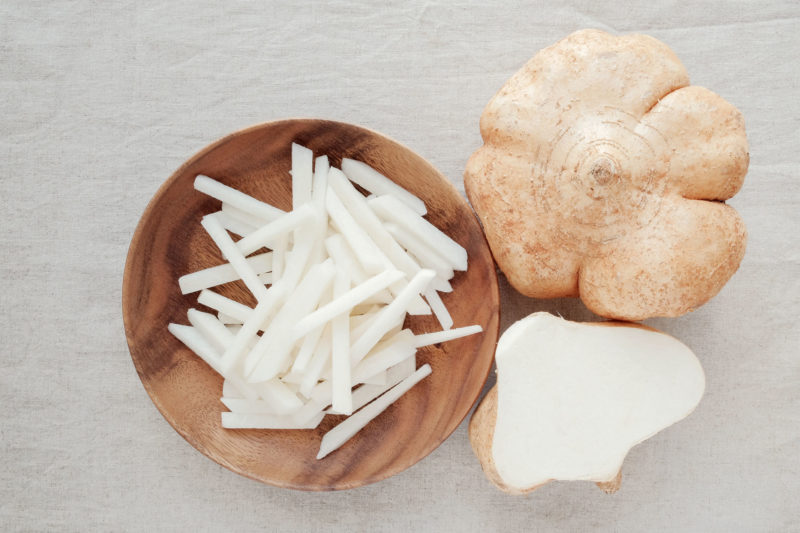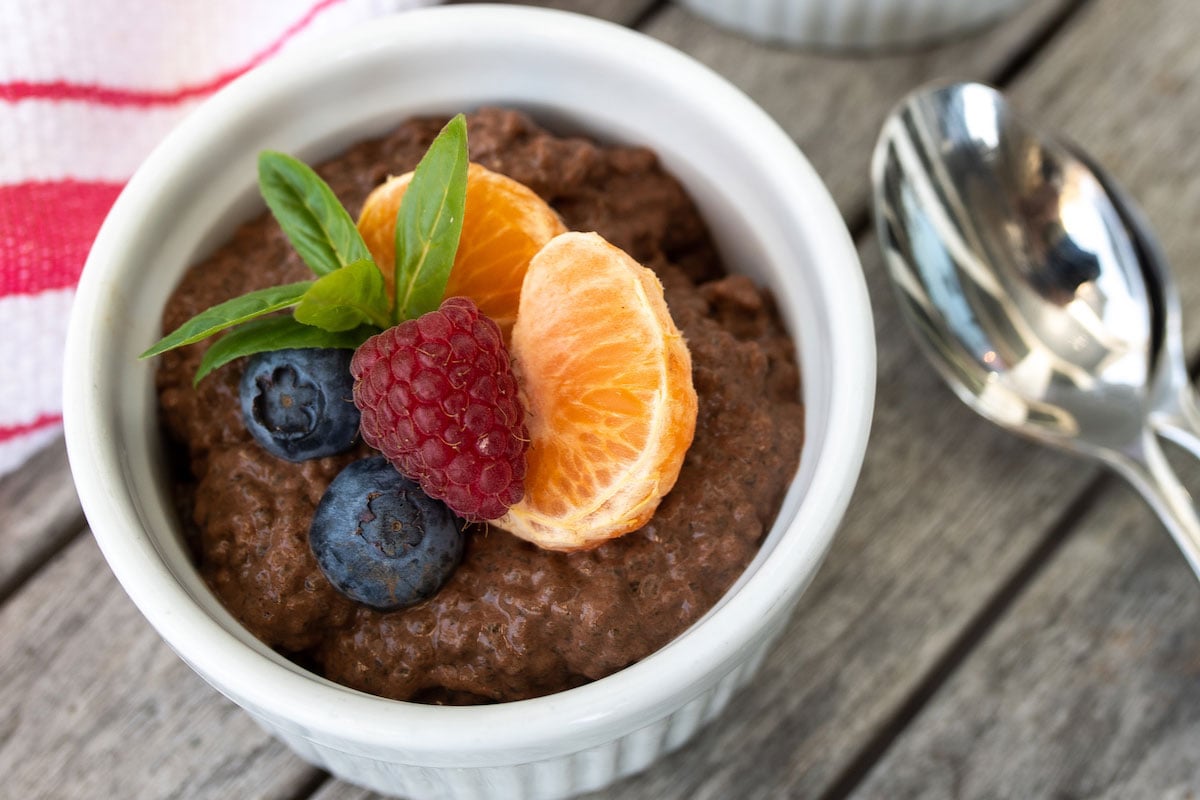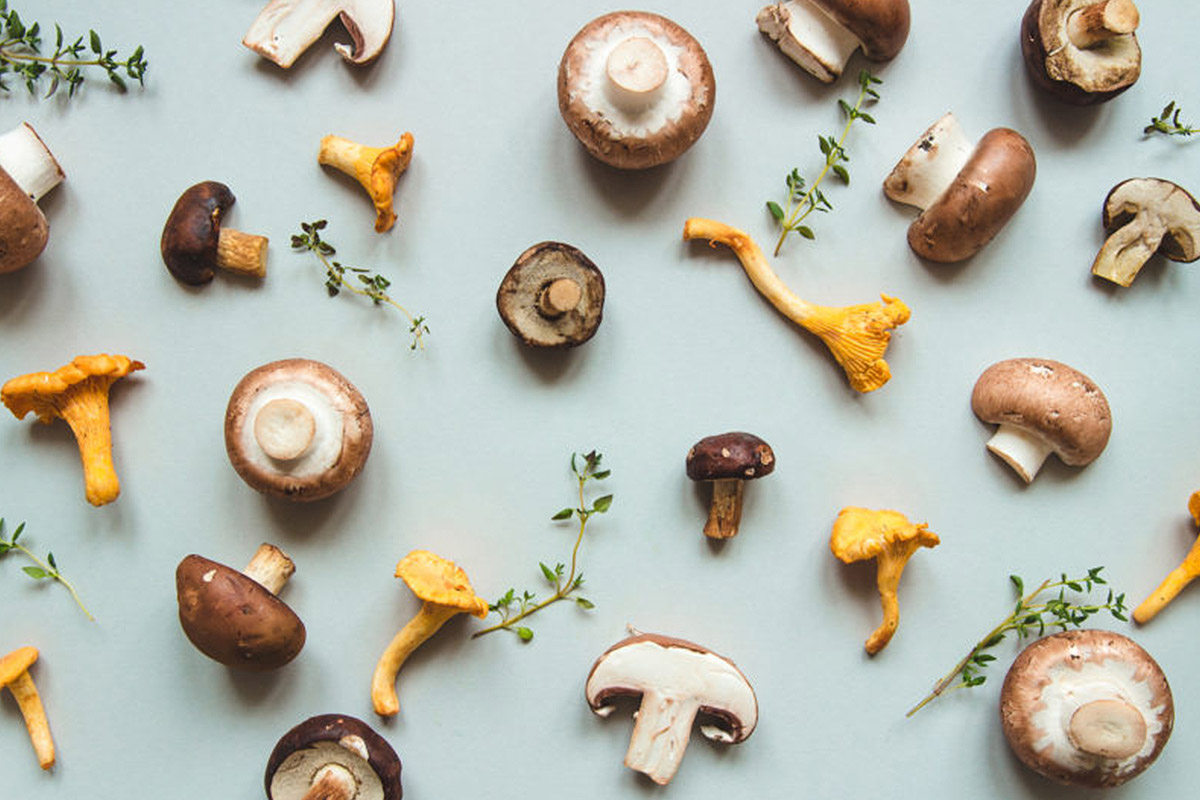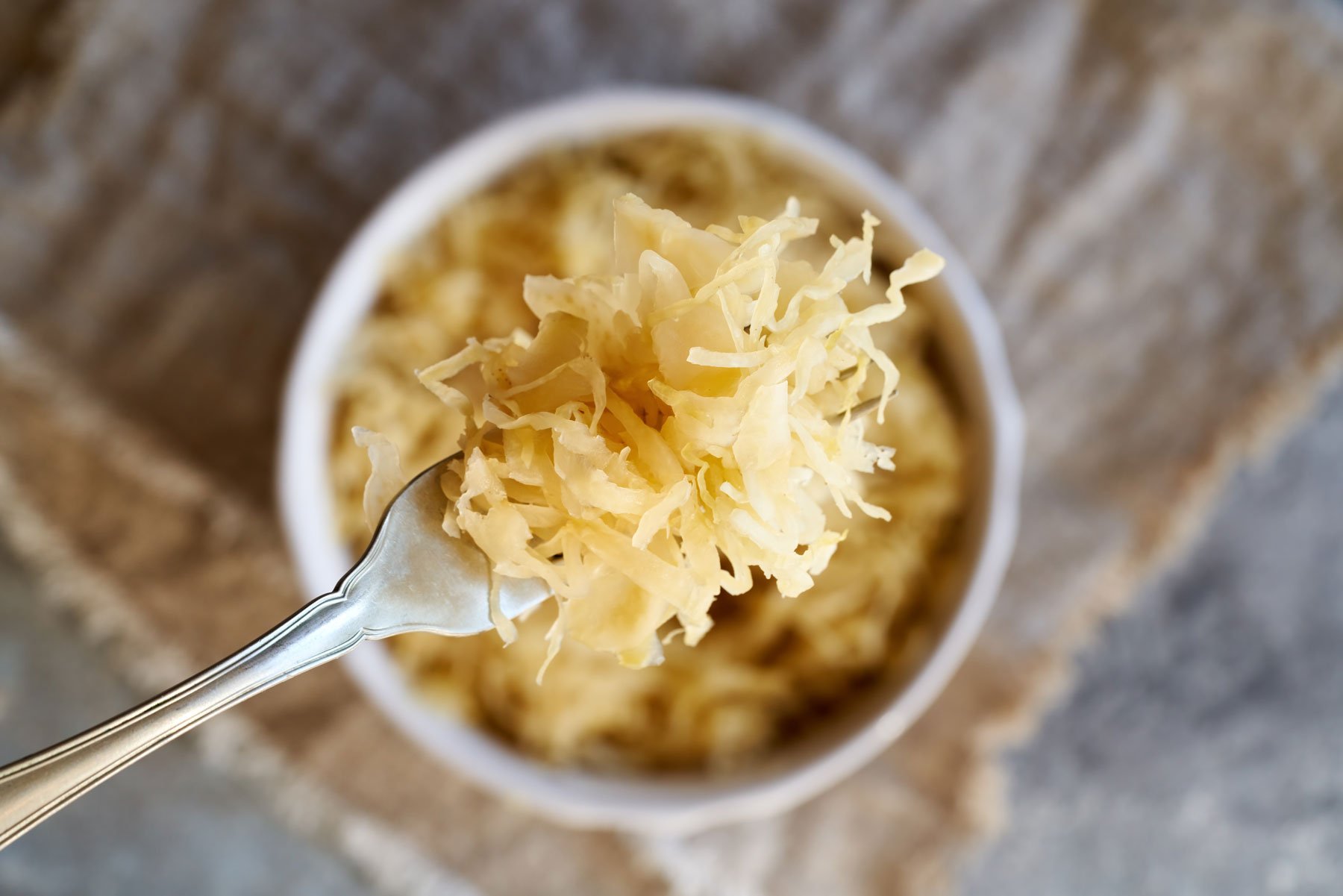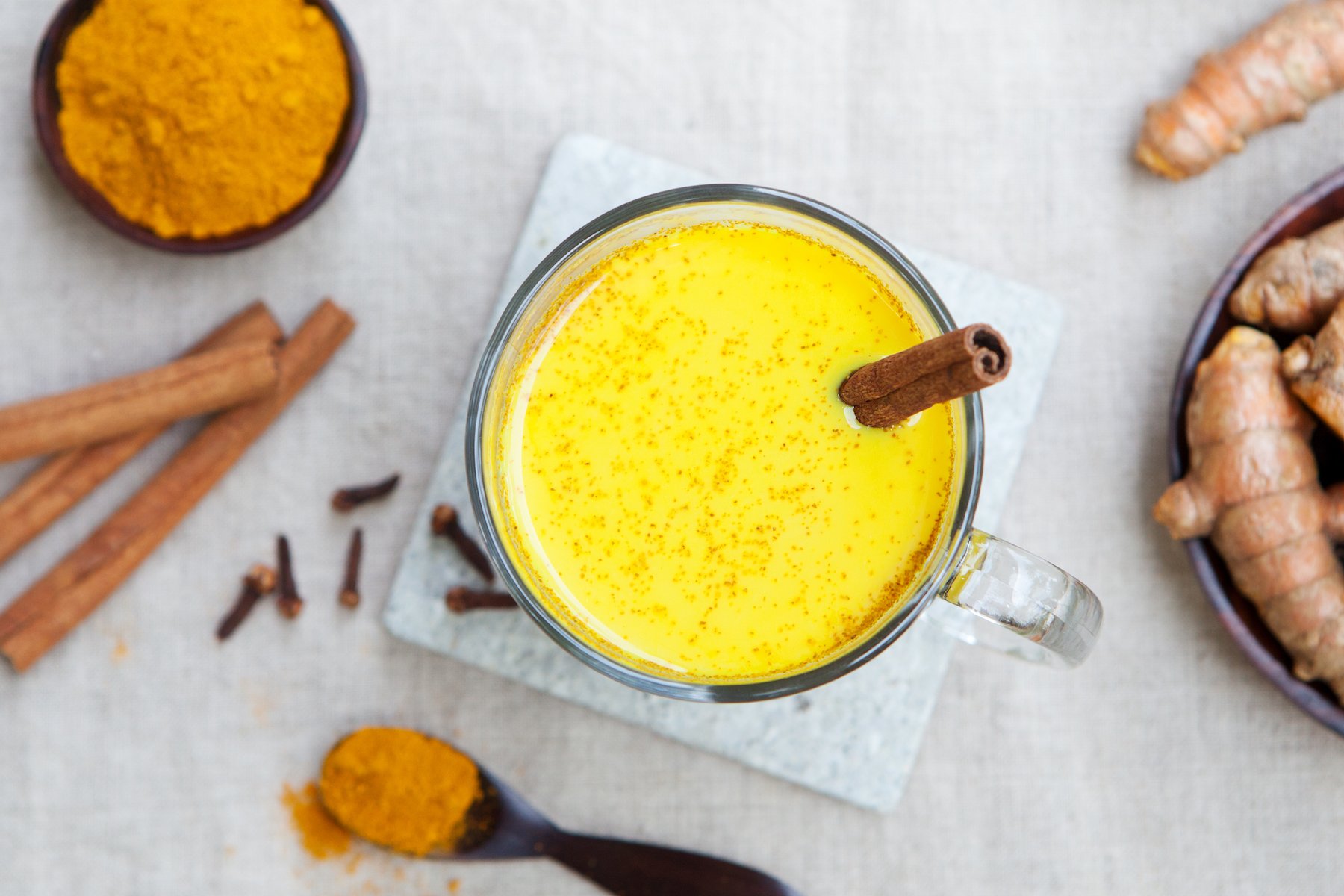Jicama Basics
Jicama (pronounced “hi-kuh-muh” or “he-kah-mah”) is a root vegetable native to Mexico and Central and South America, where it’s commonly served raw, sprinkled with lime juice and chili powder. Also known as Mexican yam, Mexican turnip, Mexican potato, and yam bean, jicama has a rounded shape similar to a turnip. Beneath jicama’s rough brown skin lies a satisfyingly crunchy, juicy white flesh with a mild flavor that’s subtly sweet, starchy, and nutty. Some liken it to a water chestnut or a potato-apple hybrid.
Raw jicama is a fantastic ingredient for boosting meals’ flavor, texture, and fiber content of meals while adding minimal calories and carbs (so it’s unlikely to spike blood sugar). It can also be cooked as a delicious addition to stir-fries or substitute for potatoes to make lower-carb fries and chips. Per cup, raw jicama contains about 49 calories, 11.5 g of carbs, 6.4 g of fiber, 2.3 g of sugar, 1 g of protein, and less than a gram of fat. (On the other hand, the same amount of baked white potato has 113 calories, 26 g of carbs, and 1.8 g of fiber.)
Jicama stands out for containing a specific prebiotic fiber— inulin—known to support a healthy gut (which is vital for metabolic health). Plus, a one-cup serving contains about a third of the recommended daily vitamin C intake.
Jicama’s Metabolic Punch
Jicama’s relatively low carbohydrate content, coupled with its high fiber and vitamin C levels, make it a smart addition to any health-optimizing diet.
A 1-cup serving of jicama has 26% of women’s recommended daily fiber intake and 17% for men (though many experts recommend a higher daily intake). Getting sufficient fiber can help manage blood sugar and cholesterol (both of which can drive metabolic disease when elevated), as well as support a healthy gut.
Case in point: Research suggests that people who eat an average of 35 g of fiber per day have lower HbA1c levels—a biomarker indicating your average blood sugar control over three months—than those consuming 19 g per day. This benefit can be explained, at least in part, by fiber’s ability to slow digestion and the subsequent absorption of glucose from the intestines into the bloodstream. This, in turn, buffers post-meal blood sugar spikes.
Jicama also contains inulin, a type of soluble fiber that acts as a prebiotic—meaning it serves as a fuel source for beneficial gut bacteria, thereby helping to promote microbial diversity and maintain a balance between anti-inflammatory and pro-inflammatory microorganisms. (Keeping inflammation in check is critical since it’s at the root of many metabolic conditions). Plus, when gut bacteria ferment prebiotic fibers like inulin, they produce metabolites called short-chain fatty acids (SCFAs), which have been associated with improved insulin sensitivity, weight regulation, and reduced inflammation. SCFAs also lower the rate of cholesterol synthesis by the liver, which could help keep cholesterol levels in a healthy range.
The predominant micronutrient in jicama is vitamin C—a cup provides 35% of the recommended daily intake for women and 29% for men. As an antioxidant, vitamin C helps curb oxidative stress in the body by neutralizing free radicals that might otherwise contribute to cellular damage, inflammation, insulin resistance, and overall metabolic dysfunction. Vitamin C also helps regenerate other antioxidants, like vitamin E.
Additionally, there are a few preliminary studies on jicama itself—specifically, how isolated jicama fiber and extracts impact biomarkers like blood glucose, insulin, and body weight. However, most studies have been done in the lab or on mice, so we need more research to extrapolate these outcomes to humans. But there are some promising findings:
- In a 2019 study, mice fed a high-sugar diet along with isolated jicama fiber (containing both insoluble fiber and soluble fiber, including inulin) experienced significantly lower increases in blood glucose, weight gain, and glucose intolerance over eight weeks than mice fed the same diet minus the jicama fiber.
- In a 2015 study, diabetic mice fed their regular diet plus jicama extract experienced lower blood glucose and HbA1c levels (i.e., the amount of glucose stuck to red blood cells, an indicator of average blood sugar over three months) and had improved markers of insulin sensitivity after six weeks compared to diabetic mice fed a regular diet without jicama.
- A 2015 study found that an isolated jicama extract solution successfully inhibited the effects of two enzymes (α-amylase and α-glucosidase) essential for digesting carbohydrates. According to researchers, this could translate to slower absorption of sugars into the bloodstream and lower post-meal blood sugar spikes. In part two of this study, mice given a starch solution with isolated jicama extract experienced lower post-meal elevations in blood sugar than mice fed the starch solution alone.
Authors of one review note that jicama’s ability to control blood sugar and potentially curb the risk of Type 2 diabetes may be attributed to its soluble fibers, including inulin, and other phytochemicals.
Jicama Buying Advice
You can find fresh, whole jicama in the produce section of many grocery stores year-round; it’s typically grown in Texas, Mexico, and South America. Choose one that’s firm and heavy for its size, with skin free of wrinkles, cracks, bruises, or discoloration. Small to medium tubers (less than 4 pounds) are typically crisper and more flavorful than larger ones, which can become unpleasantly fibrous and starchy.
In the refrigerated produce area, you might also find pre-peeled and sliced jicama sticks (like these) ready to be snacked on or added to meals. Additionally, Trader Joe’s sells Jicama Wraps, which are simply pre-packaged, thinly sliced jicama rounds that resemble tortillas but contain no additional ingredients, making them a low-carb way to get your taco or sandwich fix.
Tips for Using Jicama
Jicama is easy to work with, but you should follow some basic rules to keep it fresh and avoid ingesting the potentially dangerous compounds found in the skin:
- Store whole jicama in the refrigerator unwrapped and away from moisture. Avoid rinsing jicama until you’re ready to use it. These tubers can last up to 2-3 weeks if stored appropriately.
- Wash and peel jicama before using. Rinse under running water to remove dirt, then peel off the brown outer skin and any fibrous flesh underneath. Use a sharp chef’s knife or paring knife (not a veggie peeler) for greater efficiency, and watch this quick tutorial.
- If you use only a portion of a jicama root, the remainder can be tightly covered in plastic wrap and stored in the refrigerator for about a week.
- You can slice jicama in various ways and enjoy it raw or cooked. For example, cut jicama into rounds or thick carrot-like sticks for dipping into hummus or nut butter, dice it and add to salsas or fruit salads, or slice it into matchsticks for slaws or stir-fries.
- Only consume the white flesh of jicama tubers. The skin and other parts could make you sick.
Ideas for Eating Jicama
Jicama can be eaten cooked or raw. Its crunchy texture and mild, subtly sweet and nutty flavor allow it to pair well with a variety of flavors.
- Jicama sticks: Slice jicama into ¼-inch sticks and pair them with a dip, hummus, or nut butter for a satisfying snack. In Mexico, chilled jicama sticks seasoned with lime juice, chili powder, and salt are a traditional and refreshing snack.
- Cracker substitute: Slice jicama into rounds, then cut into your desired shape to create a low-carb cracker or chip substitute. Dollop on whatever flavor boosters you like—guac and salsa, hummus, olive tapenade, ricotta and pesto, tuna salad, etc.
- Tortilla replacement: Slice jicama tubers into thin discs and use them as “tortillas” for tacos.
- Salad or taco topper: Dice jicama or cut it into thin matchsticks and sprinkle it atop salads or tacos for a subtly sweet crunch.
- Jicama slaw: Grate or thinly slice jicama into matchsticks and combine with ingredients like shredded purple cabbage, carrots, red bell pepper, red onion, and a healthy vinaigrette or dressing for a coleslaw variation.
- Spring roll stuffer: Add thinly sliced jicama matchsticks to these low-carb collard-wrapped spring rolls for additional flavor and crunch.
- Baked jicama fries: For a low-carb, sweet, and savory take on french fries, try this: Slice jicama into ¼-inch sticks. Boil for about 10 minutes until crisp-tender. Drain and toss in olive oil. Season with salt and spices, then bake at 425 F for about 30 minutes.
- Jicama chips: For ultra-crispy jicama chips: Cut jicama into ultra-thin slices, toss in olive oil, season, and bake at 390 F for 25-30 minutes, flipping halfway through.
- Stir-fried jicama: Like water chestnuts, jicama flesh can maintain its crunchy texture even when briefly cooked, making it a great addition to stir-fries. Try it with onions, snap peas, broccoli, garlic, ginger, protein, and a low-sugar stir-fry sauce.
- Citrus-jicama salad: For a refreshing side dish, try this carrot, jicama, and orange salad featuring grated jicama and carrot, chopped orange segments, and a dressing made with mayo, lime juice, chili powder, and salt. (Opt for a high-quality mayonnaise made with avocado oil, like Primal Kitchen Mayo).
- Jicama-mango salsa: Finely dice jicama and combine with ingredients such as diced tomato, onion, red bell pepper, cilantro, lime juice, and mango for a vibrant, crunchy salsa. Try it served over grilled steak, fish, or chicken.
